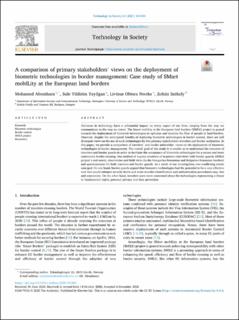| dc.contributor.author | Abomhara, Mohamed | |
| dc.contributor.author | Yildirim Yayilgan, Sule | |
| dc.contributor.author | Nweke, Livinus Obiora | |
| dc.contributor.author | Székely, Zoltán | |
| dc.date.accessioned | 2021-02-11T13:20:08Z | |
| dc.date.available | 2021-02-11T13:20:08Z | |
| dc.date.created | 2020-12-08T05:36:25Z | |
| dc.date.issued | 2021 | |
| dc.identifier.citation | Technology in society. 2021, 64 1-12. | en_US |
| dc.identifier.issn | 0160-791X | |
| dc.identifier.uri | https://hdl.handle.net/11250/2727460 | |
| dc.description.abstract | Advances in technology have a substantial impact on every aspect of our lives, ranging from the way we communicate to the way we travel. The Smart mobility at the European land borders (SMILE) project is geared towards the deployment of biometric technologies to optimize and monitor the flow of people at land borders. However, despite the anticipated benefits of deploying biometric technologies in border control, there are still divergent views on the use of such technologies by two primary stakeholders–travelers and border authorities. In this paper, we provide a comparison of travelers' and border authorities' views on the deployment of biometric technologies in border management. The overall goal of this study is to enable us to understand the concerns of travelers and border guards in order to facilitate the acceptance of biometric technologies for a secure and more convenient border crossing. Our method of inquiry consisted of in-person interviews with border guards (SMILE project's end users), observation and field visits (to the Hungarian-Romanian and Bulgarian-Romanian borders) and questionnaires for both travelers and border guards. As a result of our investigation, two conflicting trends emerged. On one hand, border guards argued that biometric technologies had the potential to be a very effective tool that would enhance security levels and make traveler identification and authentication procedures easy, fast and convenient. On the other hand, travelers were more concerned about the technologies representing a threat to fundamental rights, personal privacy and data protection. | en_US |
| dc.language.iso | eng | en_US |
| dc.publisher | Elsevier | en_US |
| dc.rights | Navngivelse 4.0 Internasjonal | |
| dc.rights.uri | http://creativecommons.org/licenses/by/4.0/deed.no | |
| dc.title | A comparison of primary stakeholders views on the deployment of biometrics technology in border management: Case study of smart mobility at the European land borders | en_US |
| dc.type | Peer reviewed | en_US |
| dc.type | Journal article | en_US |
| dc.description.version | publishedVersion | en_US |
| dc.source.pagenumber | 1-12 | en_US |
| dc.source.volume | 64 | en_US |
| dc.source.journal | Technology in society | en_US |
| dc.identifier.doi | 10.1016/j.techsoc.2020.101484 | |
| dc.identifier.cristin | 1857232 | |
| dc.description.localcode | © 2021 The Author(s). Published by Elsevier Ltd. This is an open access article under the CC BY license (http://creativecommons.org/licenses/by/4.0/). | en_US |
| cristin.ispublished | true | |
| cristin.fulltext | original | |
| cristin.qualitycode | 2 | |

